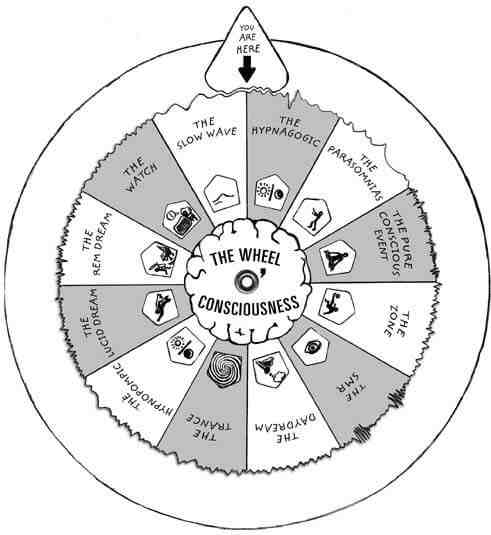In actuality there is a great range of altered states of consciousness, with each state possessing its own disctinctive characteristics and associated subjective phenomena. It would be wrong to think, however, that these different states represent mutually exclusive grades of consciousness; the whole issue would be best thought of in terms of a continuum of incredibly subtle degrees flowing smoothly into one another (just as we experience when we drift off to sleep and then wake up in the morning, through various stages of drowsiness to alertness).

Aspects of the Spectrum of Consciousness (Source)
The various states of consciousness do, however, appear to exhibit certain continuities of theme:
"ASCs share features in common... alterations in thinking, change in sense of time and body image, loss of control, change in emotional expression, perceptual distortion, change in meaning and significance, a sense of ineffability, feelings of rejuvination, and hypersuggestibility" (Winkelman, 1986, 175)
These are fundamental aspects of what constitutes our sense of self, time and place. They are dependent on the way we perceive and interact with our environment, which in turn is dependent upon our particular state of consciousness. Altering our state of consciousness consequently affects the way in which we interact with the world around us (e.g. when we are drowsy we may not fully engage with our surroundings, but when fully lucid our engagement is more complete).
What, then, are the characteristics of the mediumistic trance state?
This question can be broken down into three distinct (although interlinked) areas of focus: (1) the external behaviour of the medium; (2) the phenomenological experience of the medium; (3) the psychophysiological processes in operation during the trance state.
(1) There is a huge variety of different manifestations of spirit mediumship.
In the case of the Bristol Spirit Lodge, Jon's mediumship is characterised by remaining completely motionless, except for an intense vibration in the right hand. His eyes remain firmly shut throughout the trance communication session. Jon's behaviour indicates a redirection of attention from the external world to the internal; his closed eyes symbolising the link being made with the spirit world (as with the Hmong Shaman discussed below); a redirection of perception.
(2) Jon has described the experience of trance as follows:
"For the first half of the evening I have absolutely no awareness of what's going on externally ... I can't feel anything at all what-so-ever. Occasionally, I go off into a 'day dream?' mode and visit places and people ... but not every time. Recently I've started to feel strong energies around me (hot and cold breezes particularly on my legs), usually just before Charlie (or whoever) comes in to talk first... Often now, when they are talking I'll go back into myself and I get a strange sensation of vertigo & being detached from the conversation, not just intellectually but physically as well. As if I'm on the edge of a precipice or inside a vast canyon. It's a sense of scale I think, I feel very small in comparison to something very large?"
(3) With regard to the psychophysiological processes occurring during the trance state, it is not possible to provide a precise account of what is taking place within the physiological structure of Jon's brain, but there are certain pointers available that might shed some light on the matter.
The simple act of closing the eyes has an observable psychophysiological effect. Electoencephalograph (EEG) readings have revealed that "closing one's eyes leads to an increase in synchronous alpha patterns", which is a conconmitant effect of parasympatheitc nervous system dominance (Winkelman, 1986, 177). The frequency range of alpha waves is between 7-12 Hz. Parasympathetic dominance is characterised by hemispheric synchronisation resulting in relaxation.
 EEG brainwaves (Source)
EEG brainwaves (Source)
It would be possible to speculate, perhaps, that Jon's trance state is also associated with hemispheric synchronisation and alpha wave dominance.
An important question to ask here is that relating to the causal direction of these psychophysiological observations. Do they represent the cause of the phenomena (e.g. communications with discarnate entities are nothing more than the result of psychophysiological processes), or are the psychophysiological processes the product of some external influence (e.g. the psychophysiological changes occur because communication is taking place)?
I am of the opinion that the psychophysiological changes are necessary if communication with discarnate beings is to be achieved. The release of certain chemicals and alterations to the frequencies of our brain waves are required to tune us into another aspect of reality; in other words altered states of consciousness affect the way that we interface with reality (and there are very many different ways for us to achieve this interface).
To be continued...
***
Notes:
[1] Winkelman, M. 1986. Trance States: A Theoretical Model and Cross Cultural Analysis. Ethos, Vol. 14, No. 2, pp. 174-203.
[2] While writing this article I received an e-mail from Beatrice McCraig, an accredited medium from Scotland, concerning her interpretation of trance states and the processes involved in transmitting communications from discarnate entities.
An interesting point she brought up is a distinction between the ASC associated with Deep Trance and that associated with the Lesser Trance state (as utilised for clairvoyance, clairaudience, etc.). She suggests that Deep Trance states are associated with a relaxation whereby the medium's unconscious is utilised by the discarnate intelligence communicating, while the Lesser Trance is associated with a heightened awareness; necessary for consciously selecting the information that is received.
This seems to agree with the suggestion that deep trance states are associated with alpha waves and parasympathetic dominance. Lesser trance states utilise a different ASC, perhaps associated with dominance of the sympathetic nervous system (this system is resposnsible for making the body alert through the release of certain hormones and neurotransmitters, such as adrenaline, and leads to a hemispheric desynchronization).
To read Beatrice's article click HERE.



Learn more about Alpha Waves, Brion Gysin and the Dreamachine...
ReplyDeletehttp://www.dreamachine.ca
http://www.briongysin.ca
http://www.briongysin.com
http://www.flickerflicker.com
http://flicker.myfilmblog.com
http://www.youtube.com/user/DreamachineFlicker
http://www.octobergallery.co.uk/artists/gysin/index.shtml
http://www.forteantimes.com/features/articles/3250/dreamachine.html